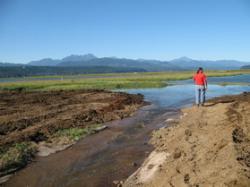Sometimes there’s just good news when it comes to conservation and mankind!
[dropcap]B[/dropcap]efore we (NOAA) started our restoration work on the Skokomish River in Washington State, almost half the estuary was blocked by dikes and levees. Fish were unable to reach upstream habitat. But now we’re seeing 20 different fish species swimming through the restored habitat – including threatened Chinook and summer chum salmon.
River deltas are landforms at the mouth of a river, where it flows into an ocean, estuary, or lake. They are flat, fertile lands near water – so, historically, they were often diked and used for farming.
That’s just what happened in the Skokomish River Estuary. Without the influence of the tides, however, the land dried up and sank, rendering it less and less usable for agriculture. Young salmon use estuaries to get ready for their long ocean migration, but the dikes meant the estuary was no longer available for fish either. Without those crucial delta habitats, the fish were pushed out to sea and weren’t able to grow as large.
In 2006, we began working with the Washington State Department of Fish and Wildlife, the Skokomish Indian Nation, and Mason Conservation District to restore the estuary. We have removed dikes across 300 acres of historical marsh, and are letting nature take its course from there. Once the estuary is reconnected to the river and tidal flow, the channels and other important fish habitat begin to reform naturally – without further help from us.
That’s what we’ve seen in the Skokomish River. As soon as the habitat returns, so do the fish – including Hood Canal summer chum and Puget Sound Chinook. Once completed, this project will have restored 360 acres of estuary swamp and marsh, doubling the area of critical fish habitat.







